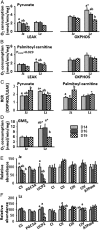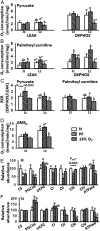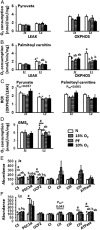Placental mitochondria adapt developmentally and in response to hypoxia to support fetal growth
- PMID: 30655345
- PMCID: PMC6358710
- DOI: 10.1073/pnas.1816056116
Placental mitochondria adapt developmentally and in response to hypoxia to support fetal growth
Abstract
Mitochondria respond to a range of stimuli and function in energy production and redox homeostasis. However, little is known about the developmental and environmental control of mitochondria in the placenta, an organ vital for fetal growth and pregnancy maintenance in eutherian mammals. Using respirometry and molecular analyses, the present study examined mitochondrial function in the distinct transport and endocrine zones of the mouse placenta during normal pregnancy and maternal inhalation hypoxia. The data show that mitochondria of the two zones adopt different strategies in modulating their respiration, substrate use, biogenesis, density, and efficiency to best support the growth and energy demands of fetoplacental tissues during late gestation in both normal and hypoxic conditions. The findings have important implications for environmentally induced adaptations in mitochondrial function in other tissues and for compromised human pregnancy in which hypoxia and alterations in placental mitochondrial function are associated with poor outcomes like fetal growth restriction.
Keywords: fetus; hypoxia; metabolism; mitochondria; placenta.
Conflict of interest statement
The authors declare no conflict of interest.
Figures



Similar articles
-
Sexual dimorphism of mitochondrial function in the hypoxic guinea pig placenta.Biol Reprod. 2019 Jan 1;100(1):208-216. doi: 10.1093/biolre/ioy167. Biol Reprod. 2019. PMID: 30085007 Free PMC article.
-
Placental phenotype and resource allocation to fetal growth are modified by the timing and degree of hypoxia during mouse pregnancy.J Physiol. 2016 Mar 1;594(5):1341-56. doi: 10.1113/JP271057. Epub 2015 Oct 26. J Physiol. 2016. PMID: 26377136 Free PMC article.
-
Placental adaptations supporting fetal growth during normal and adverse gestational environments.Exp Physiol. 2023 Mar;108(3):371-397. doi: 10.1113/EP090442. Epub 2022 Dec 9. Exp Physiol. 2023. PMID: 36484327 Free PMC article. Review.
-
Impaired mitochondrial function in the preimplantation embryo perturbs fetal and placental development in the mouse.Biol Reprod. 2011 Mar;84(3):572-80. doi: 10.1095/biolreprod.110.087262. Epub 2010 Nov 10. Biol Reprod. 2011. PMID: 21076083
-
Oxygen delivery and fetal-placental growth: beyond a question of supply and demand?Placenta. 2012 Nov;33 Suppl 2:e16-22. doi: 10.1016/j.placenta.2012.06.006. Epub 2012 Jun 27. Placenta. 2012. PMID: 22742726 Review.
Cited by
-
Impact of Ionizing Radiation Exposure on Placental Function and Implications for Fetal Programming.Int J Mol Sci. 2024 Sep 12;25(18):9862. doi: 10.3390/ijms25189862. Int J Mol Sci. 2024. PMID: 39337351 Free PMC article. Review.
-
Mechanism of Placenta Damage in Gestational Diabetes Mellitus by Investigating TXNIP of Patient Samples and Gene Functional Research in Cell Line.Diabetes Ther. 2019 Dec;10(6):2265-2288. doi: 10.1007/s13300-019-00713-z. Epub 2019 Oct 26. Diabetes Ther. 2019. PMID: 31654346 Free PMC article.
-
Gestational Exposure to Black Phosphorus Nanoparticles Induces Placental Trophoblast Dysfunction by Triggering Reactive Oxygen Species-Regulated Mitophagy.ACS Nano. 2025 May 6;19(17):16517-16533. doi: 10.1021/acsnano.4c18731. Epub 2025 Apr 23. ACS Nano. 2025. PMID: 40264356 Free PMC article.
-
Mitochondrial DNA Copy Number Adaptation as a Biological Response Derived from an Earthquake at Intrauterine Stage.Int J Environ Res Public Health. 2021 Nov 10;18(22):11771. doi: 10.3390/ijerph182211771. Int J Environ Res Public Health. 2021. PMID: 34831526 Free PMC article.
-
Prenatal exercise in fetal development: a placental perspective.FEBS J. 2022 Jun;289(11):3058-3071. doi: 10.1111/febs.16173. Epub 2021 Sep 12. FEBS J. 2022. PMID: 34449982 Free PMC article. Review.
References
Publication types
MeSH terms
Grants and funding
LinkOut - more resources
Full Text Sources
Other Literature Sources
Medical

